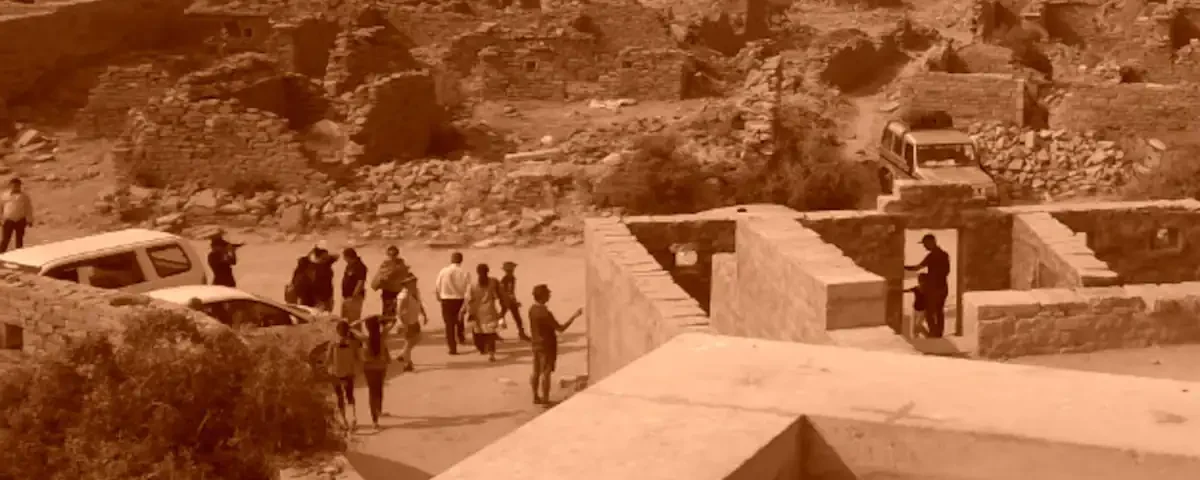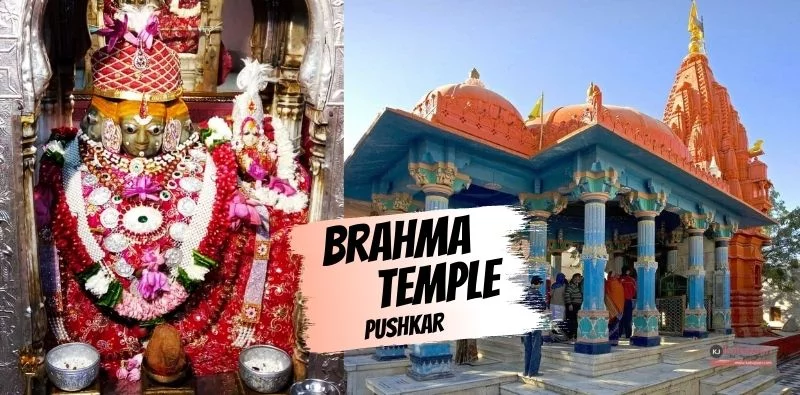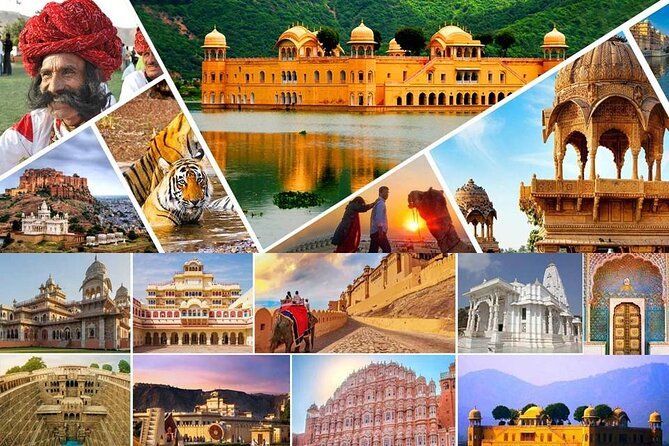- Best Taxi Services In Rajasthan
- +91-9887169999
- hellorajasthantaxi@gmail.com
Kuldhara Village, Jaisalmer: Uncovering the Haunted History of Rajasthan’s Abandoned Ghost Village

Brahma Temple Pushkar: Timings, Aarti Schedule & Significance of the Only Brahma Mandir in India
July 7, 2025Introduction: The Mystery Behind Kuldhara Village
Kuldhara Village, located near Jaisalmer in Rajasthan, is one of the most talked-about abandoned villages in India. Known for its eerie silence and haunting legends, Kuldhara has fascinated historians, cultural researchers, and curious travelers for centuries. The village, once inhabited by the wealthy and resourceful Paliwal Brahmins, was mysteriously abandoned overnight in the early 19th century, leaving behind more than 80 settlements across the region.
What makes Kuldhara stand out isn’t just its deserted homes or ruins, but the compelling stories attached to its sudden desertion. Some say the village was cursed, while others believe it was an act of collective rebellion against tyranny. These tales have contributed to its reputation as the “haunted ghost village of Rajasthan.”
Over the years, Kuldhara has become a major heritage site and a must-visit destination near Jaisalmer. Its blend of historical depth and paranormal curiosity makes it a rare place where folklore and fact intertwine, offering visitors a chance to explore a unique chapter of Rajasthan’s past.
In this blog, we uncover the Kuldhara village story, examine its historical background, explore why it was abandoned, and help you plan your visit with responsible travel tips. Whether you’re interested in heritage tourism or India’s most haunted places, this guide covers everything you need to know.
Where is Kuldhara Village Located?
Kuldhara Village is located approximately 18 to 20 kilometers west of Jaisalmer, in the arid landscape of Rajasthan’s Thar Desert. Set along the route to the popular Sam Sand Dunes, Kuldhara is easily accessible and often included in half-day or full-day sightseeing itineraries around Jaisalmer.
This abandoned village, surrounded by sand dunes and open desert skies, lies in a region that was once a vital part of desert trade routes. Its isolated location only adds to the village’s haunting atmosphere and historical intrigue.
Travel and Accessibility Details:
- Distance from Jaisalmer: Around 18–20 km via Sam Road
- Approximate Travel Time: 30 to 40 minutes by road
- Best Route: Jaisalmer → Sam Road → Kuldhara Junction
- Nearest Landmarks: On the way to Sam Dunes and Khuri Village
How to Reach Kuldhara:
- By Private Taxi or Cab: The most convenient and preferred mode for tourists. Taxis can be booked from Jaisalmer city.
- By Rental Vehicle: Two-wheelers and self-drive cars are available for rent in Jaisalmer.
- Via Local Tours: Kuldhara is included in many heritage and desert safari packages offered by local operators.
Today, Kuldhara is managed by the Archaeological Survey of India (ASI) as a protected heritage site. The village is open to tourists during the day and has signage, basic amenities, and a small entry checkpoint to preserve its remains.
While the village remains uninhabited, it draws thousands of visitors annually for its mysterious ruins, historical value, and atmospheric landscape.
Why Visit Kuldhara?
Its proximity to Jaisalmer, combined with its unique blend of folklore, history, and desert beauty, makes Kuldhara one of the most compelling stops in the region. For those visiting Jaisalmer, it offers a chance to experience a site that feels frozen in time—quiet, powerful, and deeply symbolic of Rajasthan’s forgotten stories.
Kuldhara Village History: A Glimpse into the 13th Century
The origins of Kuldhara Village date back to the 13th century, when it was founded by the Paliwal Brahmins, a highly respected and enterprising community known for their advanced knowledge of trade, agriculture, and water conservation in desert conditions.
Kuldhara was not just a single settlement—it was part of a network of 84 villages in the region, all established and managed by the Paliwal Brahmins. Their society was well-organized, self-sufficient, and economically robust, flourishing under the patronage of local Rajput rulers. Historical references and local accounts suggest that Kuldhara enjoyed relative autonomy in its functioning, owing to the social and intellectual stature of its people.
Key Highlights of Kuldhara’s Historical Foundation:
- Community: Dominated by Paliwal Brahmins, who migrated from Pali district and settled near Jaisalmer.
- Architecture: The village featured sandstone houses with courtyards, narrow lanes, temples, and a proper drainage system—typical of sustainable desert architecture.
- Water Management: Despite the arid terrain, the villagers used smart water conservation techniques such as step wells (baoris), tanks, and underground channels (kunis).
- Economy: They prospered through agriculture, trade in silk and spices, and levied small transit taxes due to their location on desert trade routes.
- Culture: The Paliwal community upheld a rich cultural heritage, with temples and festivals forming an essential part of life in the village.
According to a study published by the Archaeological Survey of India (ASI) and supported by local oral traditions, Kuldhara remained a thriving settlement for several centuries. Its population was literate, socially progressive, and resourceful—attributes that made the village an exceptional example of desert civilization management in medieval Rajasthan.
However, by the early 19th century, this flourishing village faced a sudden and irreversible decline, the reasons for which remain a blend of folklore and theory—a topic explored in the next section.
The Abandonment of Kuldhara: What Happened Overnight?
One of the most enduring mysteries of Kuldhara Village lies in its sudden and complete abandonment. According to local folklore, the entire population—along with residents of 83 neighboring villages—vanished overnight in the early 19th century. No trace of their departure or resettlement was ever recorded, and to this day, no one has successfully inhabited the village.
The Legend: A Tale of Rebellion and Sacrifice
As per the most widely shared Kuldhara village story, the downfall began with Salim Singh, the powerful and oppressive Prime Minister of the princely state of Jaisalmer. Known for his ruthless governance and inappropriate demands, Salim Singh allegedly set his eyes on the daughter of the village chief and issued a threat—either marry her to him or face dire consequences.
Rather than submit to this unjust order, the Paliwal Brahmins are believed to have taken a bold stand. In a collective act of resistance, they chose to leave their homes, abandoning not just Kuldhara, but all 84 surrounding villages. Before departing, legend says they cast a curse upon the land, ensuring that no one would ever be able to resettle in Kuldhara again.
Even today, attempts to inhabit or develop the site are said to be met with inexplicable difficulties, adding to its reputation as a haunted ghost village.
Alternative Theories: A More Rational Lens
While the legend adds a dramatic and emotional layer to Kuldhara’s mystery, historians and researchers offer several plausible explanations for the abandonment:
- Water Scarcity: The region faced increasing droughts and groundwater depletion, making long-term habitation difficult.
- Excessive Taxation: Records suggest rising taxes under feudal rulers may have driven people out of economic desperation.
- Trade Route Shifts: As desert trade patterns changed, villages that once thrived on commerce may have become unsustainable.
- Societal Pressure: Religious or caste-based tensions, combined with political oppression, may have pushed the community to migrate collectively.
Though no official documentation confirms the exact cause, archaeological studies and local accounts support the idea that a combination of environmental and socio-political stress led to the community’s decision to leave.
A Legacy Etched in Silence
Whether viewed as a story of sacrifice and defiance or a case of environmental migration, the abandonment of Kuldhara remains one of India’s most mysterious historical events. The silence of its ruins continues to speak volumes—inviting visitors to reflect on what truly happened that fateful night.
Is Kuldhara Really a Ghost Village?
Kuldhara’s reputation as a haunted village in Rajasthan has intrigued travelers, researchers, and paranormal enthusiasts alike. While the village’s historical abandonment is widely acknowledged, its status as a “ghost village” is rooted more in cultural beliefs and anecdotal experiences than in proven supernatural phenomena.
Over the years, stories have emerged of eerie sightings, unexplained sounds, and unsettling silences, adding to the mystique that surrounds this deserted landscape. Visitors often describe a stillness so profound that even footsteps on sand feel unnaturally loud.
What Fuels the Haunted Reputation?
- Local Beliefs: Many locals firmly believe the village is cursed, citing generations of oral tradition passed down within nearby communities.
- Government Signage: The tourism department has placed boards referring to Kuldhara as a “haunted site,” reinforcing its mysterious branding.
- Paranormal Investigations: Independent paranormal groups have visited Kuldhara and reported unusual readings, temperature drops, or unexplained noises—though none have provided conclusive evidence.
- Visitor Accounts: Some tourists have claimed to sense an unsettling atmosphere or seen fleeting shadows, especially near dusk. These experiences, while subjective, add to the intrigue.
A Rational Perspective
Despite its haunted image, no scientific study has ever verified any paranormal activity in Kuldhara. Most experts believe the sensations of fear or unease stem from the village’s isolation, silence, and visual decay, which naturally evoke strong psychological reactions in visitors.
It’s important to recognize that Kuldhara’s haunted status plays a role in cultural tourism and narrative preservation. The stories associated with the village are part of Rajasthan’s rich folklore tradition—meant not necessarily to frighten, but to reflect deeper social and historical experiences.
Visiting with Respect and Understanding
While the idea of visiting a haunted site might excite thrill-seekers, travelers are encouraged to approach Kuldhara with respect for local beliefs and historical significance. It is a protected heritage site that deserves thoughtful exploration, not sensationalism.
In reality, Kuldhara may not be a ghost village in the supernatural sense—but it is undeniably a place where the past lingers powerfully in every stone and silence.
Exploring Kuldhara Today: What Can You See?
A visit to Kuldhara Village today offers more than just ghost stories — it provides a powerful glimpse into the architectural brilliance, cultural legacy, and haunting atmosphere of a long-lost civilization. The site is now a protected heritage zone under the Archaeological Survey of India (ASI) and remains open to tourists during daylight hours.
As you step into the village, you’ll notice that time appears to have stood still. The structures — though weathered — still retain their original layout, offering a visual map of life from centuries ago.
Key Features to Explore:
- Ruined Stone Houses: Dozens of homes made from locally sourced yellow sandstone, featuring small courtyards, arched entrances, and crumbling boundary walls.
- Narrow Dusty Streets: The grid-like layout of the village reflects the organized town planning by the Paliwal Brahmins, with lanes wide enough for camel carts.
- Temples and Stepwells: A few temples still stand partially intact, offering insight into the spiritual life of the villagers. You may also find ancient wells and water tanks that once supported the settlement.
- The Main Gateway: Visitors enter through a partially restored stone arch, now marked with signage and maintained by the local tourism department.
Restoration and Preservation:
The ASI has taken steps to stabilize and preserve key parts of the village to prevent further decay. Informative boards have been installed to guide tourists, and basic pathways have been created for safe exploration. However, the site remains largely untouched to preserve its authenticity.
Best Time to Visit:
- Morning (8 AM – 10 AM): Soft light and cooler temperatures make it ideal for exploration.
- Evening (4 PM – Sunset): Perfect for golden-hour photography and capturing dramatic desert shadows.
- Avoid visiting at night, as the site is officially closed after sunset and local regulations prohibit after-dark entry.
Travel Tips for a Respectful Visit:
- Carry drinking water: The desert heat can be intense, especially from March to June.
- Wear comfortable shoes: The terrain is uneven and sandy.
- Hire a local guide: Many offer insightful stories and historical context that enhance the experience.
- Respect the silence: Avoid loud behavior or disrespectful conduct, especially in temples or near preserved ruins.
- Don’t climb or deface structures: Preservation of the site is a shared responsibility.
Kuldhara today is a space of reflection, where ancient ruins, desert winds, and unanswered questions combine to offer a rare travel experience. It invites visitors not just to sightsee, but to step into the echoes of a forgotten world.
Responsible Tourism and Local Sensitivities
Though often called a ghost village, Kuldhara holds much more than haunted tales—it represents a forgotten chapter of Rajasthan’s living history. To honor its past and ensure its preservation for future generations, travelers must approach it with a sense of reverence and responsibility.
Here’s how you can be a responsible visitor:
- Avoid littering or damaging the ruins. These structures are fragile remnants of a centuries-old civilization and are under protection.
- Respect local legends without sensationalizing them. Whether or not you believe in the ghost stories, these oral traditions are part of the region’s deep cultural fabric—just like the myths surrounding sacred sites such as the Brahma Temple Pushkar.
- Follow the rules of access—visits are permitted only during the day, and night stays are strictly prohibited to preserve the site’s atmosphere and safety.
- Refrain from dramatized content creation. Use your platform to educate rather than entertain at the expense of cultural significance.
Kuldhara’s inclusion in curated Rajasthan Tour Packages is a testament to its heritage value, not just its mystery. Whether you’re planning a spiritual trip or a historical one, it fits beautifully into the Best Rajasthan Itinerary, especially when paired with responsible travel services like a verified Taxi Service in Rajasthan.
By treading respectfully, you become not just a tourist—but a preserver of history.



